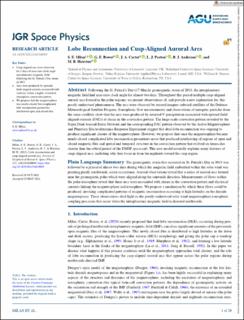| dc.contributor.author | Milan, Stephen Eric | |
| dc.contributor.author | Bower, G.E. | |
| dc.contributor.author | Carter, J.A. | |
| dc.contributor.author | Paxton, L.J. | |
| dc.contributor.author | Anderson, B.J. | |
| dc.contributor.author | Hairston, M.R. | |
| dc.date.accessioned | 2023-03-01T13:07:14Z | |
| dc.date.available | 2023-03-01T13:07:14Z | |
| dc.date.created | 2022-09-07T13:47:47Z | |
| dc.date.issued | 2022 | |
| dc.identifier.issn | 2169-9380 | |
| dc.identifier.uri | https://hdl.handle.net/11250/3055019 | |
| dc.description.abstract | Following the St. Patrick's Day (17 March) geomagnetic storm of 2013, the interplanetary magnetic field had near-zero clock angle for almost two days. Throughout this period multiple cusp-aligned auroral arcs formed in the polar regions; we present observations of, and provide a new explanation for, this poorly understood phenomenon. The arcs were observed by auroral imagers onboard satellites of the Defense Meteorological Satellite Program. Ionospheric flow measurements and observations of energetic particles from the same satellites show that the arcs were produced by inverted-V precipitation associated with upward field-aligned currents (FACs) at shears in the convection pattern. The large-scale convection pattern revealed by the Super Dual Auroral Radar Network and the corresponding FAC pattern observed by the Active Magnetosphere and Planetary Electrodynamics Response Experiment suggest that dual-lobe reconnection was ongoing to produce significant closure of the magnetosphere. However, we propose that once the magnetosphere became nearly closed complicated lobe reconnection geometries arose that produced interleaving of regions of open and closed magnetic flux and spatial and temporal structure in the convection pattern that evolved on timescales shorter than the orbital period of the DMSP spacecraft. This new model naturally explains many features of cusp-aligned arcs, including why they focus in from the nightside toward the cusp region. | en_US |
| dc.language.iso | eng | en_US |
| dc.publisher | AGU | en_US |
| dc.rights | Navngivelse 4.0 Internasjonal | * |
| dc.rights.uri | http://creativecommons.org/licenses/by/4.0/deed.no | * |
| dc.title | Lobe Reconnection and Cusp-Aligned Auroral Arcs | en_US |
| dc.type | Journal article | en_US |
| dc.type | Peer reviewed | en_US |
| dc.description.version | publishedVersion | en_US |
| dc.rights.holder | Copyright 2022 The Author(s) | en_US |
| dc.source.articlenumber | e2021JA030089 | en_US |
| cristin.ispublished | true | |
| cristin.fulltext | original | |
| cristin.qualitycode | 2 | |
| dc.identifier.doi | 10.1029/2021JA030089 | |
| dc.identifier.cristin | 2049511 | |
| dc.source.journal | Journal of Geophysical Research (JGR): Space Physics | en_US |
| dc.identifier.citation | Journal of Geophysical Research (JGR): Space Physics. 2022, 127 (6), e2021JA030089. | en_US |
| dc.source.volume | 127 | en_US |
| dc.source.issue | 6 | en_US |

